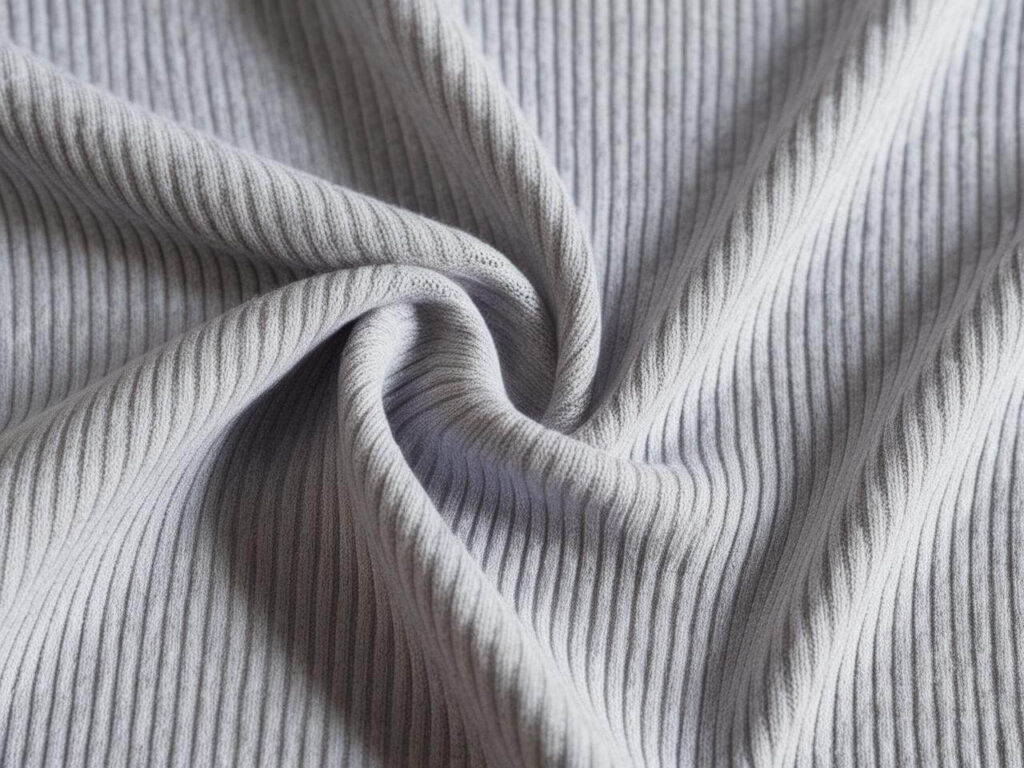Introduction
I’ve always appreciated fabrics that combine comfort with flexibility, and rib knit fabric is a perfect example. Whether used in T-shirts, cuffs, waistbands, or fitted garments, rib knit fabric stretches naturally, making it ideal for body-hugging clothing and durable trims.
But what exactly is rib knit fabric, and how does it differ from other knit fabrics like jersey or interlock? In this guide, I’ll break down its properties, benefits, and common applications.
What You’ll Learn in This Guide
✔ What rib knit fabric is and how it’s made
✔ Key characteristics that make it ideal for stretchable and fitted clothing
✔ How rib knit compares to single jersey, interlock, and woven fabrics
✔ Best uses in fashion, activewear, and home textiles
What is Rib Knit Fabric?
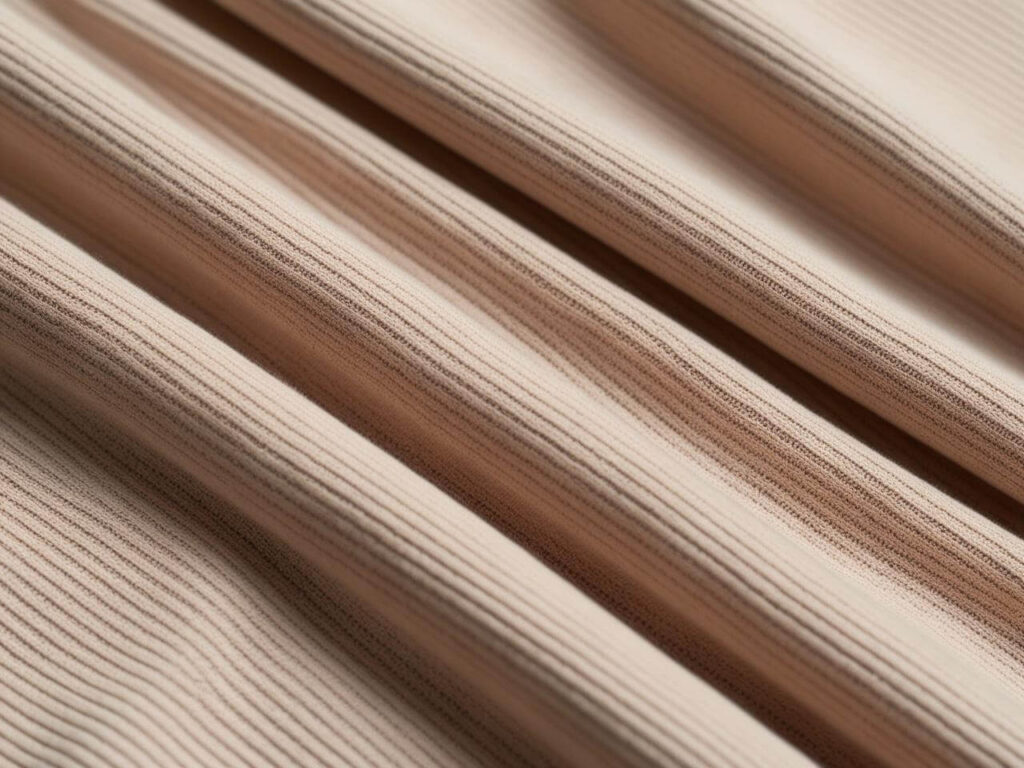
Rib knit fabric is a highly elastic, textured knit fabric known for its raised vertical ribs, which are created by alternating knit and purl stitches. This unique knitting structure gives rib knit fabric its signature stretch and excellent shape retention.
📌 Key Features of Rib Knit Fabric
- Distinct Ribbed Texture – Alternating raised and recessed lines create a structured look and feel.
- Superior Stretchability – More elastic than single jersey fabric, making it ideal for fitted clothing.
- Excellent Shape Retention – Holds its shape even after multiple washes.
- Soft & Comfortable – Flexible and breathable, providing a snug yet comfortable fit.
- Versatile Applications – Commonly used in waistbands, cuffs, collars, and stretch garments.
| Feature | Description |
| Texture | Raised vertical ribs |
| Stretchability | Highly elastic, form-fitting |
| Breathability | Moderate, depending on fiber type |
| Durability | Holds shape well, resists deformation |
| Best Uses | Cuffs, waistbands, fitted clothing, activewear |
✅ Key Advantage: Rib knit fabric provides natural elasticity without the need for spandex, making it ideal for stretchy garments and trims.
🎥 Recommended YouTube Video
📌 Understanding Rib Knit Fabric – Texture & Stretchability
🎬 A fabric expert explains why rib knit fabric is widely used in fashion and activewear.
Characteristics of Rib Knit Fabric
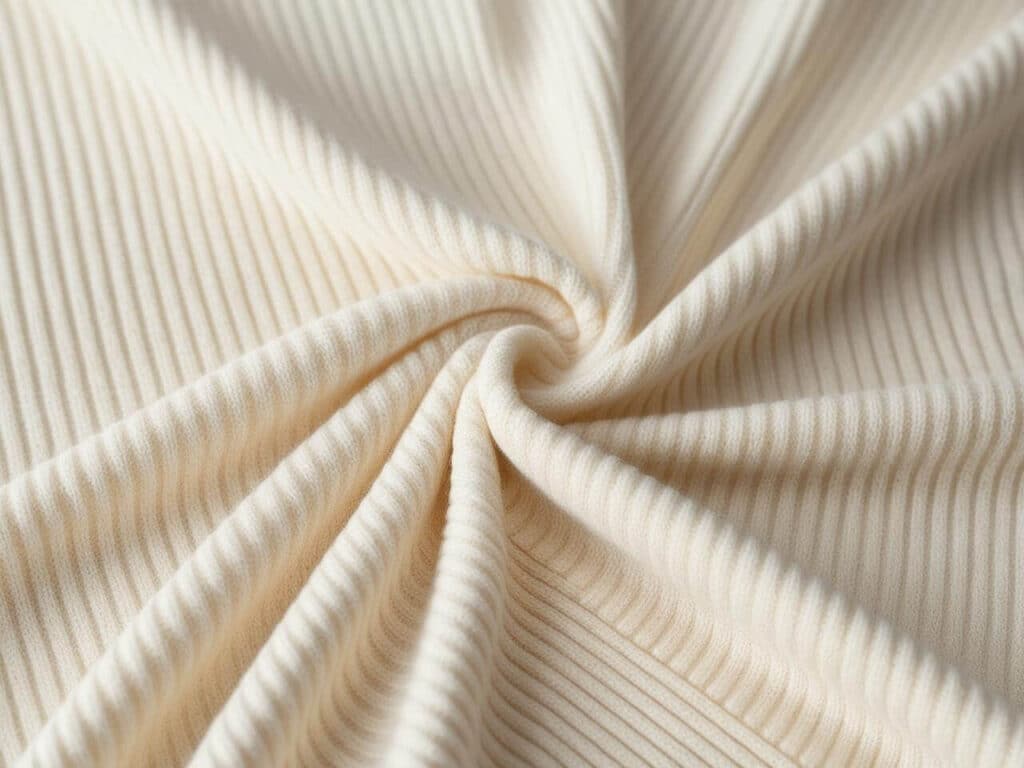
Rib knit fabric is highly valued for its elasticity, structure, and durability, making it an essential textile for fitted clothing and functional trims. Below are its defining characteristics:
📌 1. High Elasticity & Shape Retention
- Rib knit fabric can stretch up to twice its width and return to its original shape without losing its structure.
- This makes it ideal for snug-fitting garments, cuffs, and waistbands.
📌 2. Comfortable & Breathable
- Made from cotton, polyester, wool, or blends, rib knit fabrics offer good airflow and comfort.
- Cotton-based rib knits are especially soft and breathable, suitable for everyday wear.
📌 3. Durable & Resistant to Wear
- Due to its interlocking stitch structure, rib knit fabric is stronger than single jersey, making it less prone to tearing.
- Holds shape well, reducing fabric deformation even after multiple washes.
📌 4. Naturally Wrinkle-Resistant
- Unlike woven fabrics, rib knit fabric does not crease easily, making it low maintenance.
📌 5. Available in Different Weights & Textures
- Lightweight rib knits are used in t-shirts and undergarments.
- Heavyweight rib knits provide added warmth and structure, making them ideal for sweaters and winter wear.
🎥 Recommended YouTube Video
📌 Why Rib Knit Fabric is Perfect for Stretchable Clothing
🎬 A short video explaining rib knit fabric’s elasticity, durability, and fashion applications.
How is Rib Knit Fabric Made?
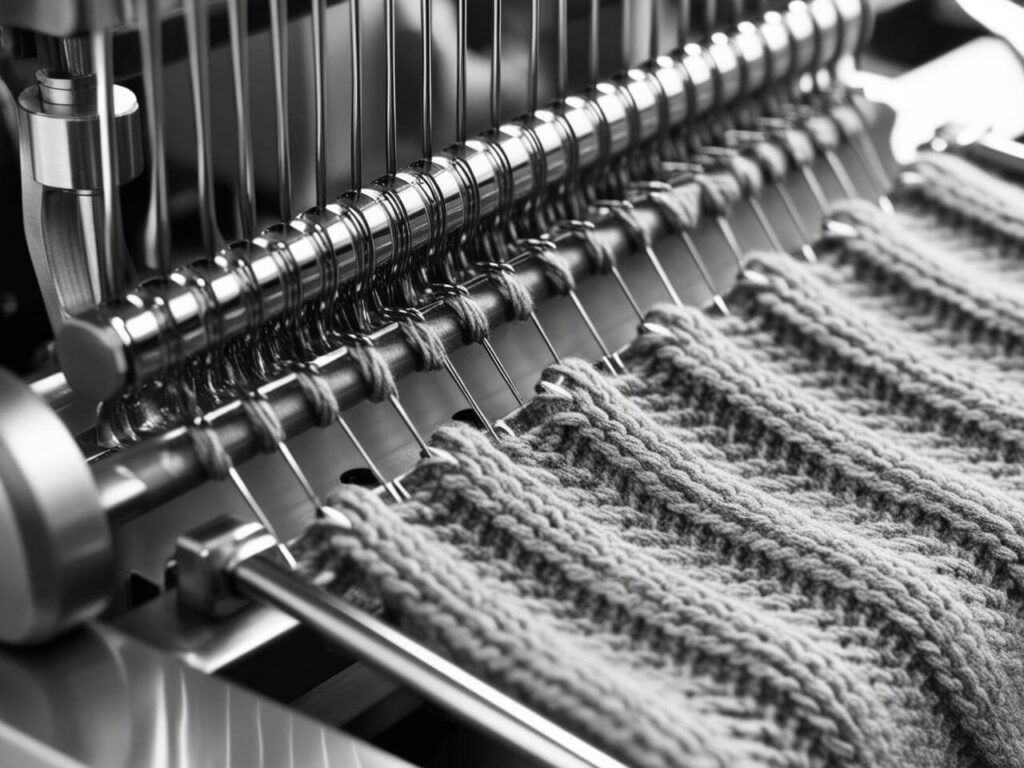
The unique elasticity and texture of rib knit fabric come from its specialized knitting technique, which alternates knit and purl stitches to create its signature vertical ribs.
📌 1. Rib Knit Construction Process
- Knitting Method: Made using circular or flat knitting machines, alternating knit and purl stitches.
- Ribbing Effect: The pattern creates raised and recessed lines, giving it enhanced stretch and structure.
- Fiber Variations: Typically made from cotton, polyester, wool, or spandex blends for different levels of stretch and durability.
📌 2. Types of Rib Knit Fabric
| Type | Description & Properties | Best Uses |
| 1×1 Rib Knit | Most common, offers moderate stretch | T-shirts, cuffs, neckbands |
| 2×2 Rib Knit | More defined ribs, higher elasticity | Waistbands, form-fitting garments |
| 3×3 Rib Knit | Wider ribs, more structured texture | Sweaters, jackets, outerwear |
| Rib Knit with Spandex | Added stretch and recovery | Activewear, compression wear |
📌 3. Finishing & Treatments
To improve performance and longevity, rib knit fabrics may undergo various finishing processes, such as:
- Pre-shrinking – Reduces fabric shrinkage after washing.
- Anti-pilling treatment – Prevents fabric from developing fuzz or lint.
- Moisture-wicking finish – Enhances breathability, especially in polyester rib knits for sportswear.
🎥 Recommended YouTube Video
📌 How Rib Knit Fabric is Made – Knitting Process Explained
🎬 A behind-the-scenes look at rib knit fabric production and its stretch properties.
Uses & Applications of Rib Knit Fabric
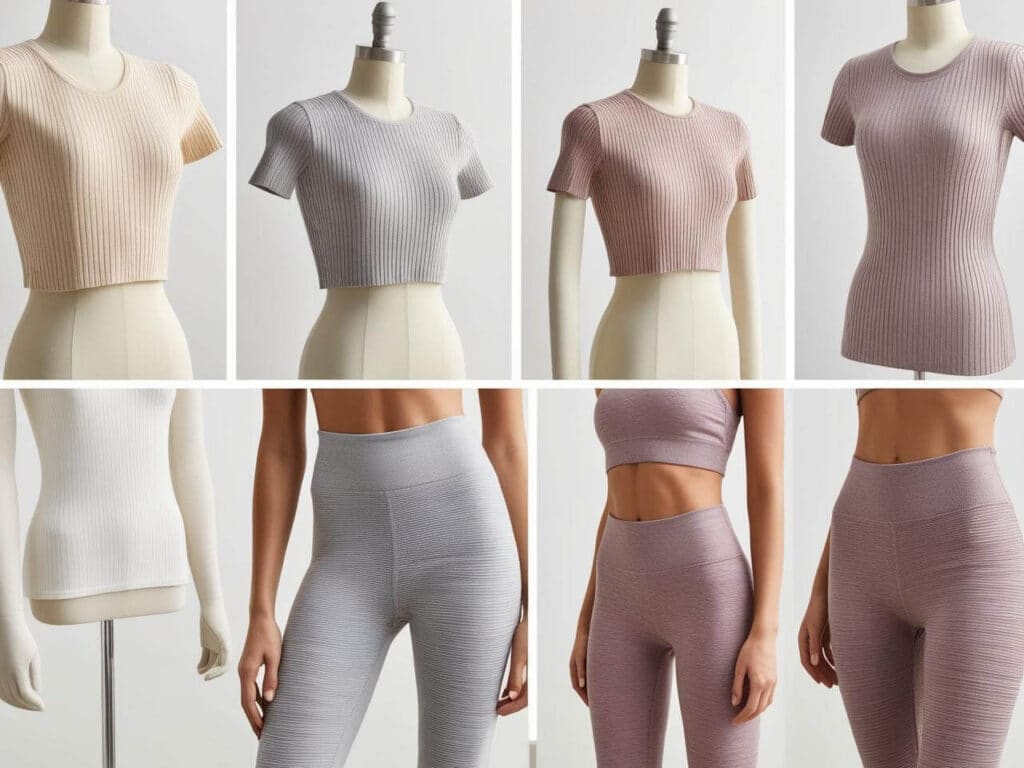
Due to its high elasticity, structure, and comfort, rib knit fabric is widely used across fashion, activewear, and home textiles.
📌 1. Clothing & Fashion Industry
Rib knit fabric is a staple material in fashion due to its stretchability and ability to maintain shape.
| Garment Type | Why Rib Knit is Used |
| T-Shirts & Base Layers | Provides a snug, flexible fit |
| Neckbands & Cuffs | Retains shape, prevents stretching out |
| Waistbands & Hemlines | Adds elasticity for comfortable fitting |
| Sweaters & Knitwear | Soft, warm, and retains structure |
| Tank Tops & Dresses | Enhances body-hugging silhouettes |
✅ Best for: Fitted garments, trims, and comfortable everyday clothing.
📌 2. Activewear & Performance Textiles
Thanks to its stretch and moisture management properties, rib knit is often used in sportswear and performance garments.
| Application | Why It’s Ideal |
| Compression Wear | Stretches and adapts to body movements |
| Yoga & Gym Wear | Flexible, breathable, and sweat-wicking |
| Sports Leggings | Holds shape while allowing free movement |
✅ Key Advantage: Blended with spandex, rib knit offers exceptional flexibility and durability.
📌 3. Home Textiles & Specialty Uses
Beyond clothing, rib knit fabric is also used for home decor and specialty applications.
- Stretchable Bed Sheets – Provides a snug fit around mattresses.
- Pillow Covers & Cushion Covers – Soft, flexible, and wrinkle-resistant.
- Winter Accessories (Scarves, Beanies, Gloves) – Warm, elastic, and form-fitting for colder weather.
🎥 Recommended YouTube Video
📌 Why Rib Knit Fabric is Perfect for Stretchable Clothing
🎬 A detailed explanation of rib knit’s elasticity, durability, and various applications.
Rib Knit vs Other Knit Fabrics
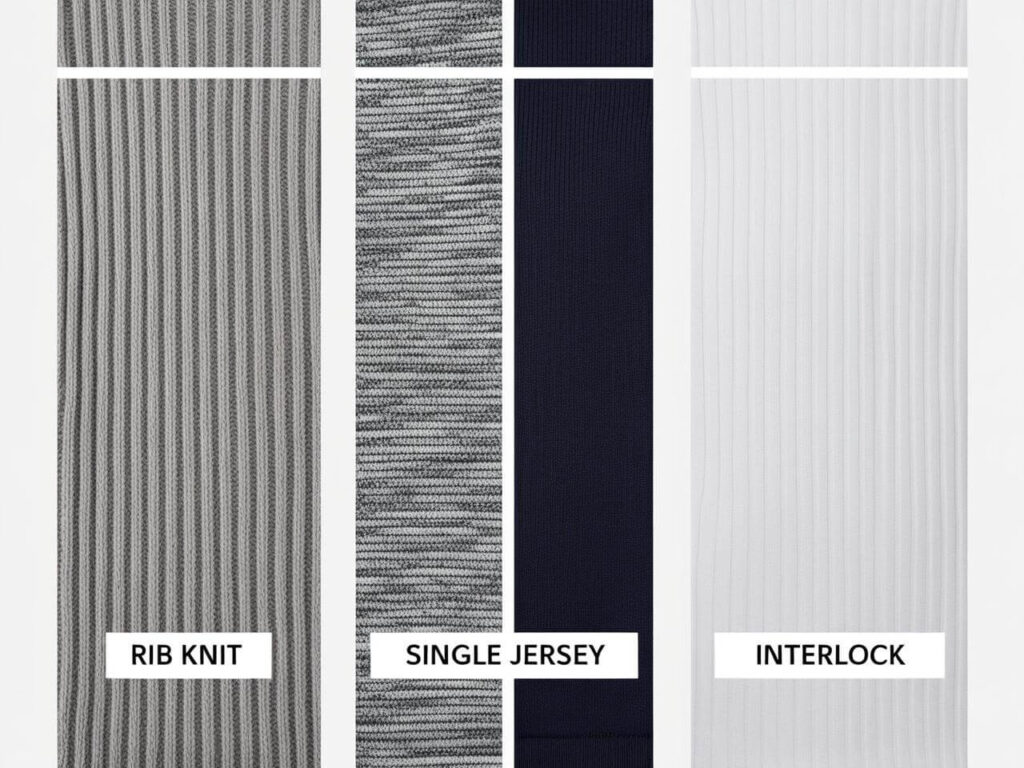
To understand why rib knit fabric is widely used, let’s compare it with other knit fabrics such as single jersey, interlock, and woven cotton.
📌 1. Rib Knit vs. Single Jersey
| Feature | Rib Knit Fabric | Single Jersey Fabric |
| Texture | Raised vertical ribs | Smooth, flat surface |
| Stretchability | High elasticity, holds shape well | Some stretch, but less than rib knit |
| Thickness | Medium to thick | Lightweight |
| Best Use | Cuffs, waistbands, fitted clothing | T-shirts, casualwear |
✅ Key Takeaway: Rib knit fabric is stretchier and more structured, while single jersey is softer and more breathable.
📌 2. Rib Knit vs. Interlock Knit
| Feature | Rib Knit Fabric | Interlock Fabric |
| Elasticity | Highly stretchable | Moderate stretch |
| Thickness | Varies (1×1, 2×2, 3×3) | Usually thicker and heavier |
| Best Use | Trims, fitted garments | Sportswear, loungewear, babywear |
✅ Key Takeaway: Interlock is more stable and thicker, while rib knit offers greater flexibility and stretch.
📌 3. Rib Knit vs. Woven Cotton
| Feature | Rib Knit Fabric | Woven Cotton |
| Fabric Type | Knitted | Woven |
| Stretchability | Naturally elastic | No stretch unless blended with spandex |
| Best Use | T-shirts, activewear, trims | Button-up shirts, bedding, formalwear |
✅ Key Takeaway: Rib knit is stretchable and casual, while woven cotton is structured and formal.
🎥 Recommended YouTube Video
📌 Rib Knit vs. Single Jersey – Key Differences
🎬 A video comparing rib knit fabric and other knit materials, explaining their stretch, texture, and applications.
Pros & Cons of Rib Knit Fabric
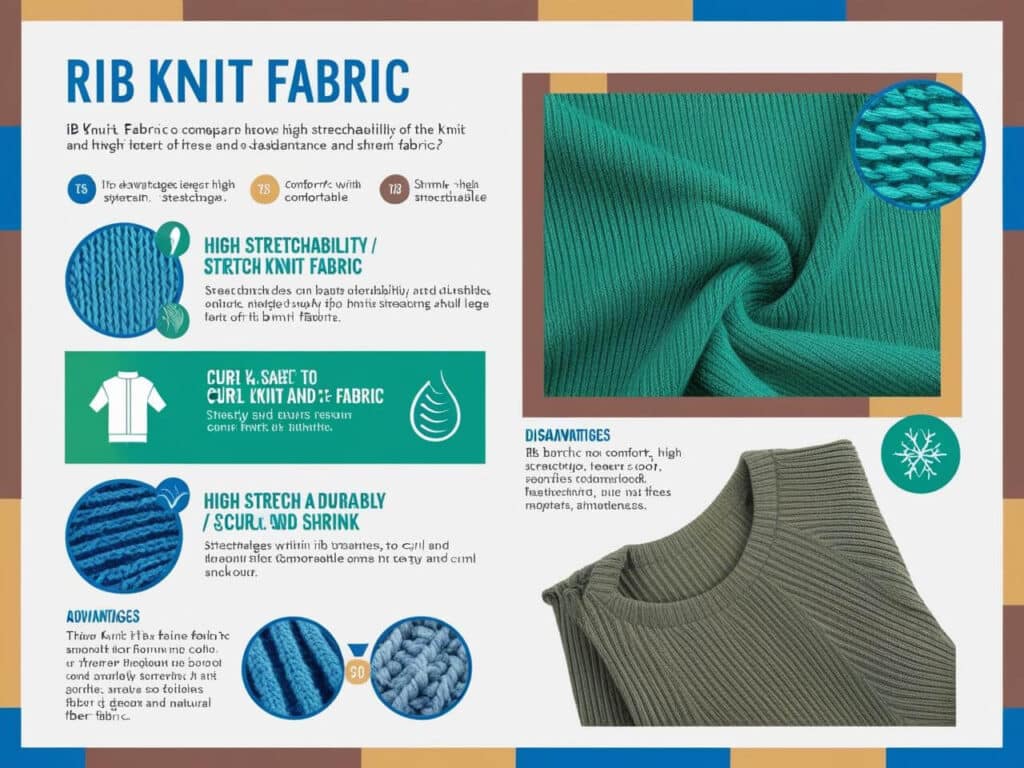
While rib knit fabric is a popular choice for fashion, activewear, and trims, it has both advantages and drawbacks. Here’s a breakdown:
📌 1. Advantages of Rib Knit Fabric
✅ High Stretch & Flexibility – Naturally elastic, making it perfect for fitted garments and trims.
✅ Shape Retention – Holds its form well, even after repeated stretching and washing.
✅ Soft & Comfortable – Offers a smooth, body-hugging feel, great for T-shirts, leggings, and undergarments.
✅ Versatile Weight Options – Available in lightweight (for base layers) and heavyweight (for sweaters and winter clothing).
✅ Low Maintenance & Wrinkle-Resistant – Unlike woven fabrics, rib knit doesn’t easily wrinkle.
📌 2. Disadvantages of Rib Knit Fabric
❌ Can Curl at the Edges – If not finished properly, cut edges may roll, making sewing tricky.
❌ Prone to Shrinking (Especially 100% Cotton) – Must be pre-washed or blended with spandex to reduce shrinkage.
❌ Less Breathable Than Single Jersey – The thicker knit structure makes it slightly less airy.
❌ May Stretch Out Over Time – Without spandex or proper finishing, rib knit can lose some elasticity after extensive use.
🎥 Recommended YouTube Video
📌 The Pros & Cons of Rib Knit Fabric – Is It Right for You?
🎬 A breakdown of rib knit fabric’s strengths and weaknesses.
FAQs: Everything You Need to Know About Rib Knit Fabric
To clarify common doubts about rib knit fabric, here are concise and informative answers to frequently asked questions.
❓ Is rib knit fabric stretchy?
✔ Yes! Rib knit fabric is one of the most elastic knit fabrics due to its alternating knit and purl stitch construction, making it perfect for fitted garments and trims.
❓ Does rib knit cotton shrink?
✔ It can shrink, especially if it’s 100% cotton. Pre-washing and blending with spandex or polyester can help reduce shrinkage.
❓ What is the difference between rib knit and single jersey?
✔ Rib knit has raised vertical ribs, providing more stretch and structure.
✔ Single jersey is smoother and lighter, making it better for breathable T-shirts and casualwear.
❓ Does rib knit fabric curl?
✔ Yes, it can. The cut edges tend to curl, which can make sewing more challenging. Proper hemming or using stabilizing finishes helps reduce curling.
❓ What is rib knit fabric best used for?
✔ Most commonly used for:
- T-shirts & base layers (comfortable & form-fitting)
- Cuffs, collars & waistbands (provides elasticity & structure)
- Activewear & leggings (stretchable & moisture-wicking)
- Winter accessories (beanies, scarves, gloves)
🎥 Recommended YouTube Video
📌 Rib Knit Fabric Explained – Common FAQs
🎬 A short video covering rib knit fabric properties, shrinkage, and best applications.
Final Thoughts: Why Rib Knit Fabric is a Staple in Fashion & Activewear
Rib knit fabric is a versatile, stretchable, and durable textile that plays an essential role in fashion, sportswear, and home textiles. Whether you’re looking for a snug-fitting T-shirt, an elastic waistband, or a warm winter sweater, rib knit fabric offers comfort, flexibility, and structure.
✔ Key Takeaways
✅ Highly elastic & form-fitting – Perfect for cuffs, waistbands, and body-hugging clothing.
✅ Durable & maintains shape – Holds its structure well, even after frequent washing.
✅ Soft & comfortable – Suitable for everyday wear and activewear.
✅ Low maintenance & wrinkle-resistant – Ideal for casual and functional clothing.
✅ Available in different weights – Lightweight for T-shirts, heavyweight for sweaters and winterwear.
If you’re considering rib knit fabric for your next sewing or fashion project, it’s a reliable, comfortable, and flexible choice that balances stretch with durability.
